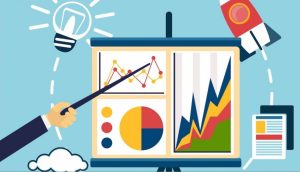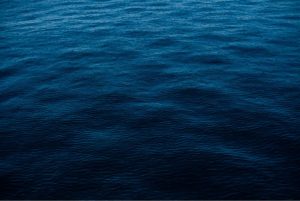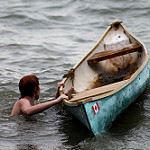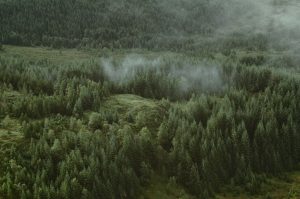Twitter Expert Connect Assignment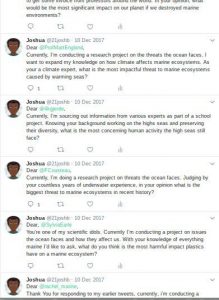
(Bruns, Joshua.)
All the people I followed during the “Twitter Expert Connect” assignment were connected to Marine Biology. Marine Biology has always been a passion of mine, and given the chance to explore anything I wanted it had to be related to something blue. Given that I wanted to invest my time in marine biology, I chose and followed a host of specialist engaging in various aspects of it. I followed marine biologists such as @rachel_marine, @AlexDavidRoger, and @SylviaEarle, and advocates like @4kgjerde, @FCousteau, @celinecouseau. Another major group I followed were professors, like @Prof_CallumYork, and @ProfMattEngland. Finally, I also followed a BBC correspondent, @MattMcGrathBBC and a leader of a climate organization, @Oceana_Andy. I chose a variety of people working on marine biology so as to get the greatest diversity of opinions, and information on the trade.
The field of experts I chose during the “Expert Connect Assignment” is conveniently related to my Genius Hour Project, about threats the ocean faces. All the experts I followed in some way help protect our oceans, whether it be through advocacy, research, etc. Judging by their jobs and role in protecting the ocean these people fit perfectly under the criteria of my Genius Hour Project and would have useful knowledge about the threats the ocean faces. Most marine biologists could easily identify threats to the ocean and are therefore already connected to my Genius Hour Project. By having my Genius Hour Project, and Twitter Expert Connect assignment project so closely related the knowledge I gain in one can easily be applied to the other.

(Mierement, Ben.)
The themes of the questions I asked my experts about during the Expert Connect Assignment, had to do with dangers to ocean biodiversity. I included many questions asking about, ocean damage they’ve seen physically, their opinions on what is the oceans biggest threat, and finally asking about individual topics and how harmful they are, e.g. plastic pollution. Additionally, all the information requested related to my Genius Hour Presentation and connected to threats the ocean faces.
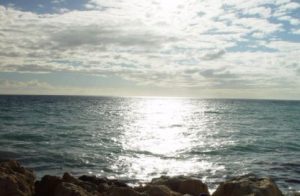
(Brooks, Leon.)
The questions I asked my experts were tailored to their professional research field. As I was following a diverse group of experts I could, in turn, get information from many points of views. I picked the style of the question I asked an expert based on their profession. An example of this, is that I asked all the Marine biologists and advocates about things they physically see in the field. Whiles, when talking to CEOs of environment groups and scientist my questions generally had to do more with, “what threats the ocean faces from human activity?” and, “how biodiversity loss will affect humans?”
The potential information collected from the Twitter questions I asked could have been very beneficial to Genius Hour. As my Genius Hour and Twitter Connect Assignment are so closely related I can apply information from one to the other. Genious Hour also requires a lot of research, sometimes just to even identify the subjects you’re project will discuss. It makes life so much easier if an expert can help nudge you in the right direction, either by giving you their input into important aspects of the topic or by providing you with their opinions and data. Many of the experts I approached have various degrees and years of experience. What they believe to be important usually is, and therefore is worth contemplating and even focusing part of my Genius Hour Project on. The advice/answers of a PhD holder is a useful resource that can, in turn, elevate the quality of your own work.
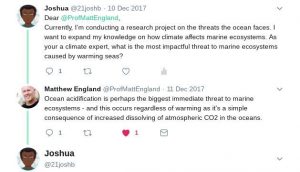
(Bruns, Joshua.)
From the ten questions I sent out, I got two responses, and a like on one of my tweets. The two people who responded were, @ProfMattEngland, a scientist at the University of Sydney, and @FCousteau, the grandson of the marine pioneer Jacques Cousteau. Although both of them responded to my questions it was @ProfMattEngland who gave me a quality answer. In response to my question about, “what was the most impactful threat on our seas,” he gave me a multi-sentence response tweet totalling at 207 characters. @FCousteau also gave me a response, the question was also about the biggest threats to marine ecosystems. He simply replied, “humans……”
Only one expert followed me back throughout the whole project, this was marine biologist @rachel_marine. She had followed me since the beginning of the assignment, starting just after the introductory tweet. Surprisingly, the one and only tweet of mine she responded to was my introductory tweet, where she told me about her job as a sponge researcher in the artic. Throughout the project, she also liked a series of my tweets, including the question I tweeted to her.
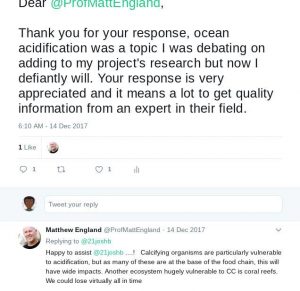
(Bruns, Joshua.)
The only expert who seemed to offer assistance to me was @ProfMattEngland. I thanked him for replying to my question, he in return continued the conversation saying, “Happy to assist @21joshb…..!” before talking more about the subject of ocean acidification. Although he was the only expert I continued the conversation with, I also responded and thanked @FCousteau for his response, I also included a follow-up question asking about what human activity causes the most marine harm, in order to clarify his first answer. So in all, the only person who not only offered assistance in some way but also continued the conversation was @ProfMattEngland, although I hope @FCousteau will respond to my reply I ‘m not optimistic, as it has been two weeks since I sent it.
Before this project I never imagined using Twitter, I just never connected with it, it was never fun for me to use and I didn’t need it as a resource. Yet, this project has changed all my views on the platform, it really can be used for good and to source quality information. Knowing that there are so many experts connected to it, ready to help and answer the questions of average students like me, Twitter seems more like a database then social media. I surely will be using Twitter more often in the future during research projects, it is truly amazing how it enables one to connect with real-life experts whose job it is to research the topics you’re simply looking at in class. Students like me can really find another side of Twitter that can help advance our education and give us good quality research.
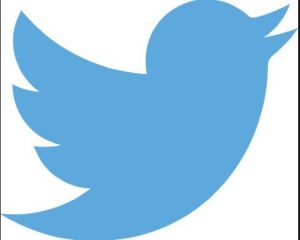
(“Twitter Bird.”)
Image works cited
Brooks, Leon. “Pacific Ocean up Sun from the Rocks.” Wikimedia Commons, Wikimedia Commons, 28 Feb. 2013, commons.wikimedia.org/wiki/File:Pacific_ocean_up_sun_from_the_rocks.jpg.
Bruns, Joshua. “Twitter Image.” Twitter.com, Twitter, 21 Jan. 2018, twitter.com/21joshb/status/941309328325251078.
Mierement, Ben. “reef2129, NOAA’s Coral Kingdom Collection.” NOAA Photo Library, NOAA.gov, www.photolib.noaa.gov/htmls/reef2129.htm.
“Twitter Bird.” Pixabay, Pixabay, 4 Aug. 2014, pixabay.com/en/twitter-tweet-twitter-bird-312464/.


